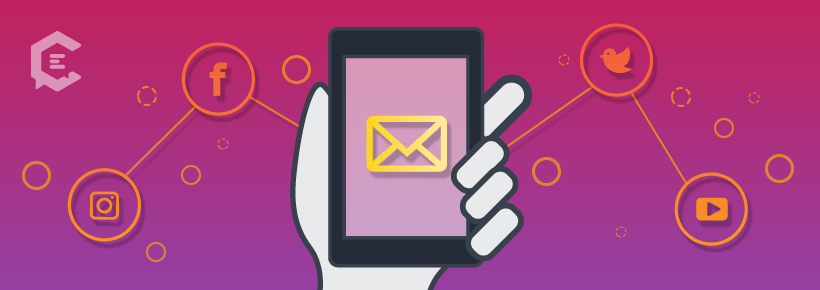In this series, we’re exploring the emerging and shifting world of newsletters. While once considered link-farm engines, they have evolved into a sophisticated platform for telling a brand’s compelling and unique message. In part one, we discuss why — despite popular beliefs — the newsletter is not only alive and well, but thriving.
In today’s media landscape, content can be described in one word: digestible. While certainly, there are exceptions to this rule when you consider the provoking, long-form features of The Atlantic, New Yorker, The New York Times, and other timeless publications, solid writing isn’t merely reserved for newspapers and magazines anymore. These days, content is used to tell the message of a brand, of a person, a website or a company through various media.
Arguably, right up there with the vast importance of having a social media presence is illustrating your value and positioning via newsletter.
After all, to remain relevant, you have to constantly get in front of your customers, wherever they are. And more likely than not, they aren’t paging through several clicks to read 5,000+-word prose. They’re clicking off the iPhone alarm, rolling over, opening their email and thumbing through the latest.
As career branding expert Wendi Weiner explains, brand marketing in the digital age is the way to go: “With people shopping online more than ever, and because we live in a world where people are digitally-focused, it is imperative for brands to have an email focus in marketing and content strategies,” she explains. Here’s a look at why this low-hanging fruit can help tell your story, get you gigs — and remain pertinent:
Why newsletters are not just about open rates
Historically, newsletter have a reputation for being clickbait warriors: sensational headlines that force you to open, only to be confronted with a web of links that lead to disappointing articles. That’s not the case anymore. In fact, for many writers who want to improve their retention, attract new readers, and tell what sets them apart in a competitive field, strongly written content can set them apart from others. And if you have a knack for shorter-form copy that’s poignant, there is cold, hard cash to be found in freelancing.
Becoming accomplished in this arena — whether you’re a writer developing your brand or penning for a company — is calculated differently these days, too.
“There are ways to measure newsletter success by viewing open rates, seeing if there are click-throughs to the sites, and assessing whether or not the company is acquiring additional revenue,” Weiner explains. Instead, newsletters are turning away from link farms and auto-generated feeds, but highlighting authentically written messages that keep email readers looking forward to the next surge.
As an example, blogger and nutritionist Amy Gorin, MS, RDN, write a weekly e-newsletter for her site, appropriately titled, “Amy’s Eat List.” Though she used to write newsletters when she worked at Parents magazine, this is a new approach. These blasts include personal recommendations and help maintain her brand’s message through various touch points, and more importantly, reach a variety of people. “Running a newsletter allows you to create a list of people interested in your brand. Sending out regular content keeps those people engaged and more likely to continue showing interest in your brand and product,” she explains.
What you miss out on sans newsletters
You’ve heard it before: “Email is dead” and “social media killed the newsletter.” Weiner says this isn’t the case, by a landslide. Here’s the obvious kicker: everyone consumes content and information differently. While some are prone to scroll through Facebook or Instagram, others are more reliant on their email. Regardless of their most common method of interaction though, Weiner says, on average, it takes 12 interactions for someone to purchase from a company, become a fan or create any sense of loyalty. So the more ways you come at someone, the more likely you are to win them over.
While plenty of brands are under the impression their social handles can replace newsletters all together, the reality is more readers trust the content that’s lurking in Gmail or Outlook than they do whatever is splashed online. And as Weiner says, you stay in front of them in a way a social media algorithm can’t promise: “Without an email list, you are basically waiting around for clients and prospects to contact you, rather than being proactive and keeping your clients in the loop,” she explains. “Prior to someone engaging with you or hiring you, through email marketing, you are able to build trust and rapport with them.”
For Gorin, the ability to position herself in front of her readers when she needs it or when a sponsored opportunity comes along is invaluable. Or big news. Or anything that needs attention… now. Unlike a blog post, which may or may not be read, or a Facebook share that could be ignored, a newsletter is based off specific folks who have agreed to be sent content. This means they might be more likely to engage, as opposed to other types of readers.
The niche advantage of email to share stories
Remember the days of RSS feeds? Depending on if you were an earlier adopter of the Internet, you might not. As perhaps the most original version of newsletters, this type of content wasn’t exactly user-friendly, but it did put all of your must-reads in one central place. As the web and content has evolved, so has the strategy of newsletters. Because they do more than just funnel clicks to a website, but also build rapport and engaging stories or characters, Weiner says it’s important to understand your specific niche advantage. And more importantly: Cater to it, wholeheartedly.
More often than not, Weiner says approaching your strategy with vulnerability and authenticity is the best way to go. “Some people use newsletters to market a funnel program to convert leads into sales, but what actually works best, according to marketing research, is sharing stories of success from your clients, bite-size tips and strategies that your readers can use, and news about your recent achievements and accolades,” she explains. “Ultimately, you want to connect your reader to your newsletter through valued content.” While everyone can’t be a Lenny, you can use the long arms of email to weave stories unique to your company, your personal brand or your goals.
Perhaps Gorin said it best when she described the consistency of emails: “While we don’t for sure know the future of social media, we can control our own websites and newsletter lists. It’s one part of a brand that you can have full control over.” As a new way to interact online pops up near-daily and Facebook continuously changes its best practices and methods, newsletters remain a dependable way to connect. Weiner notes it is actually even easier for brands to collect emails, thanks to social media, since it has fostered the ability for companies to acquire them very easily, propelling lists to grow in mass size.










